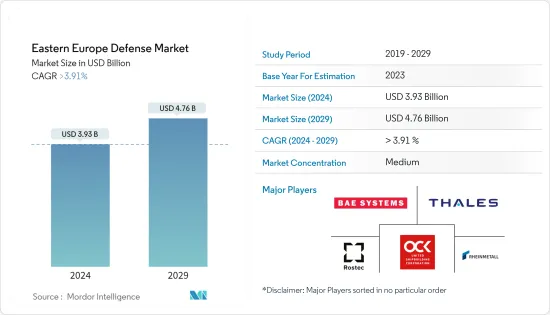PUBLISHER: Mordor Intelligence | PRODUCT CODE: 1519874

PUBLISHER: Mordor Intelligence | PRODUCT CODE: 1519874
Eastern Europe Defense - Market Share Analysis, Industry Trends & Statistics, Growth Forecasts (2024 - 2029)
The Eastern Europe Defense Market size is estimated at USD 3.93 billion in 2024, and is expected to reach USD 4.76 billion by 2029, growing at a CAGR of greater than 3.91% during the forecast period (2024-2029).

The military expenditure of the region continued to increase, driven by the regional conflicts and the push for modernization. According to SIPRI, the defense spending of the countries in the region totaled USD 181 billion in 2023, an increase of 31% compared to that of 2022 and 118% higher than that of 2014.
Furthermore, the Russian invasion of Ukraine, the most significant armed conflict in the region since the Second World War, is expected to propel the defense spending of the region in the years to come. Countries in the region are going through many military modernization plans, and they are planning to upgrade their armed, naval, and air forces. Such factors may drive the market in the coming years. The growing perceptions of the threat from Russia and calls from the United States to the NATO countries to increase their defense spending will be the growth drivers for the market.
The industry faces challenges due to the high costs of advanced technologies. Developing and deploying cutting-edge systems, including sophisticated sensors, EO/IR systems, and unmanned platforms, involves substantial investments. The high cost poses a barrier for some entities, hindering the adoption and creating a challenge for the industry.
Eastern Europe Defense Market Trends
Vehicles Segment to Dominate Market Share During the Forecast Period
- In 2024, the vehicles segment dominated the market, owing to the region's various ongoing upgrade and procurement programs. Currently, most of the investments are being directed toward fleet expansion initiatives. Additionally, fleet modernization plans are underway for many countries, as most of the fleet in the region belonged to the Soviet era. Many countries in the region are members of NATO and have vowed to increase their military spending to 2% of the GDP. Countries such as Poland and Russia are focusing on expanding their fleet of naval vessels, thereby propelling the segment's growth.
- In recent years, Russian authorities have been conducting trials on the new spy aircraft, dubbed the All-Seeing Eye. The aircraft is a Beriev A-100 retrofitted with 20 tons of unique surveillance equipment. The AEW&C aircraft is built on the latest version of the Ilyushin Il-76 military transport aircraft. The A-100 sports an active electronically scanned array radar (AESA) in its rotating radome. These aircraft are expected to replace the existing A50 aircraft in the Air Force fleet.
- In addition, as of January 2022, 13 nuclear-powered submarines were at different stages of construction in the Russian shipyards. They are all expected to be delivered to the Navy before 2027. The Russian Navy plans to build and procure 40 Project 12,700 mine countermeasure vessels by 2035.
- In addition to the naval capabilities, countries are developing their aerial and terrestrial capabilities for surveillance and combat missions. In April 2022, Hungary announced that it had ordered 12 modern Aero Vodochody L-39NG trainer aircraft. The first aircraft will be delivered in 2024. Such procurements are anticipated to propel
Poland to Show Significant Growth During the Forecast Period
Eastern Europe Defense Industry Overview
Additional Benefits:
TABLE OF CONTENTS
1 INTRODUCTION
- 1.1 Study Assumptions and Market Definition
- 1.2 Scope of the Study
2 RESEARCH METHODOLOGY
3 EXECUTIVE SUMMARY
4 MARKET DYNAMICS
- 4.1 Market Overview
- 4.2 Market Drivers
- 4.3 Market Restraints
- 4.4 PESTLE Analysis
5 MARKET SEGMENTATION
6 COMPETITIVE LANDSCAPE
7 MARKET OPPORTUNITIES AND FUTURE TRENDS




